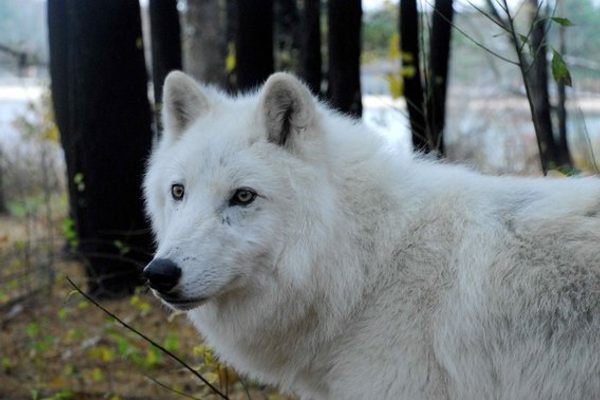Society Adventures: An Evening Wolf Howl
Arctic Gray wolf Atka at the Wolf Conservation Center of South Salem, New York (via NY Wolf- Wolf Conservation Center)
Earlier this month, Obscura Society New York headed north to the Wolf Conservation Center of South Salem, New York. One of the pre-eminent facilities in the eastern United States for the captive breeding and pre-release care of critically endangered Red and Mexican Gray wolf populations, the Wolf Conservation Center is actively involved in the survival and recovery plan for both species. Plagued by centuries of fear and hunting at the hands of humans, Red and Mexican Gray wolves were both once killed to the point of complete extinction in the wild. With the help of facilities such as the Wolf Conservation Center, wolf populations are gradually struggling to make a come back. Even so, Red and Mexican Gray wolves remain amongst the rarest of North American mammals, with only a few hundred living members of each species worldwide and the majority found in captivity.
We began our evening with a campfire discussion of the center’s wolves, from the drama of individual wolf family politics, to the sorrows and joys of a recent litter of healthy newborn pups which had to be taken from their guarded den because of their mother’s poor record of keeping her children alive. The little ones were successfully adopted by wolves at another facility and are alive and well, making the stressful extraction from their mother and father worth the trauma.
Our host Alex Spitzer with sibling wolves Zephyr and Alawa (photograph by Allison Meier)
Our host Alex also spoke about the struggle of reintroducing critically endangered wolves to the wild. Wolves still face a great deal of fear and are not always welcome back in their native territories. We learned that it’s unfortunately not uncommon for a wolf to be successfully bred in captivity and prepared for reintroduction only to found shot or poisoned soon after its release. Dispelling some of the negative mythology surrounding wolves is one of the biggest challenges facing the recovery of wolf populations.
To ensure a greater probability of a successful release into the wild, the center’s Mexican Gray and Red wolf populations must maintain a fear of humans and therefore have minimal human contact. Their enclosures are heavily wooded to ensure privacy, making chances of seeing these rare wolves slim. While we weren’t so lucky as to be visited by members of either of the critically endangered species, we were able to interact with Zephyr, Alawa, and Atka, three ambassador wolves which have been raised to be fairly comfortable around humans as a part of the WCC’s efforts to educate the public and promote tolerance and a better understanding of wolves.
Zephyr and Alawa vying for chicken livers (photograph by Allison Meier)
The first enclosure we visited held ambassador wolves Zephyr and Alawa. Zephyr and Alawa are brother and sister Canadian/Rocky Mountain Gray wolves that are just over two years old. We watched as the bonded pair happily devoured their dinner of chicken livers. While technically full grown adults at their age, Zephyr and Alawa were quite active and playful with each other and a lot of fun to watch.
Atka looking regal in the moonlight (photograph by Allison Meier)
The culmination of the evening was a visit to the center’s rockstar ambassador, Atka. Atka is a stunning, white, 11-year old Arctic Gray wolf. He’s the only one of the Ambassador wolves who travels and he’s been all over the northeast visiting schools, museums, and nature centers. He was described by the staff as a bit of a diva, magnificent to look at and seemingly aware of it. We watched him enjoy his dinner before trying to encourage him to join us in a group howl. He seemed to find our first group howl fairly pathetic, casting us a judgmental look before sauntering away. This only inspired us to kick it up a notch and we howled a second time and then a third before Atka finally deemed it worthwhile to join in and completely overpowered our chorus with his own long, deep, mournful howl.
Wishing the siblings farewell with one last evening photograph (photograph by Allison Meier)
Having the opportunity to interact with Zephyr, Alawa, and Atka was thrilling. Wolves and humans have had a complicated relationship for centuries, and currently the survival of these magnificent animals is critically dependent on aid and tolerance from humans. With only several hundred Red and Mexican Grays remaining worldwide, it was a rare and moving experience to be able to spend an evening in nature, surrounded by a forest full of wolves.
Check out the Wolf Conservation Center’s website for more information on their programs and events. You can also keep up with Atka, Alawa, and Zephyr, as well as the center’s Mexican Gray and Red wolf populations, via their own personal live web cams.
The Obscura Society is the real-world exploration arm of Atlas Obscura We seek out secret histories, unusual access, and opportunities for our community to explore strange and overlooked places hidden all around us. Join us on our next adventure!
All Upcoming Obscura Society Events
Facebook: Obscura Society San Francisco








Follow us on Twitter to get the latest on the world's hidden wonders.
Like us on Facebook to get the latest on the world's hidden wonders.
Follow us on Twitter Like us on Facebook